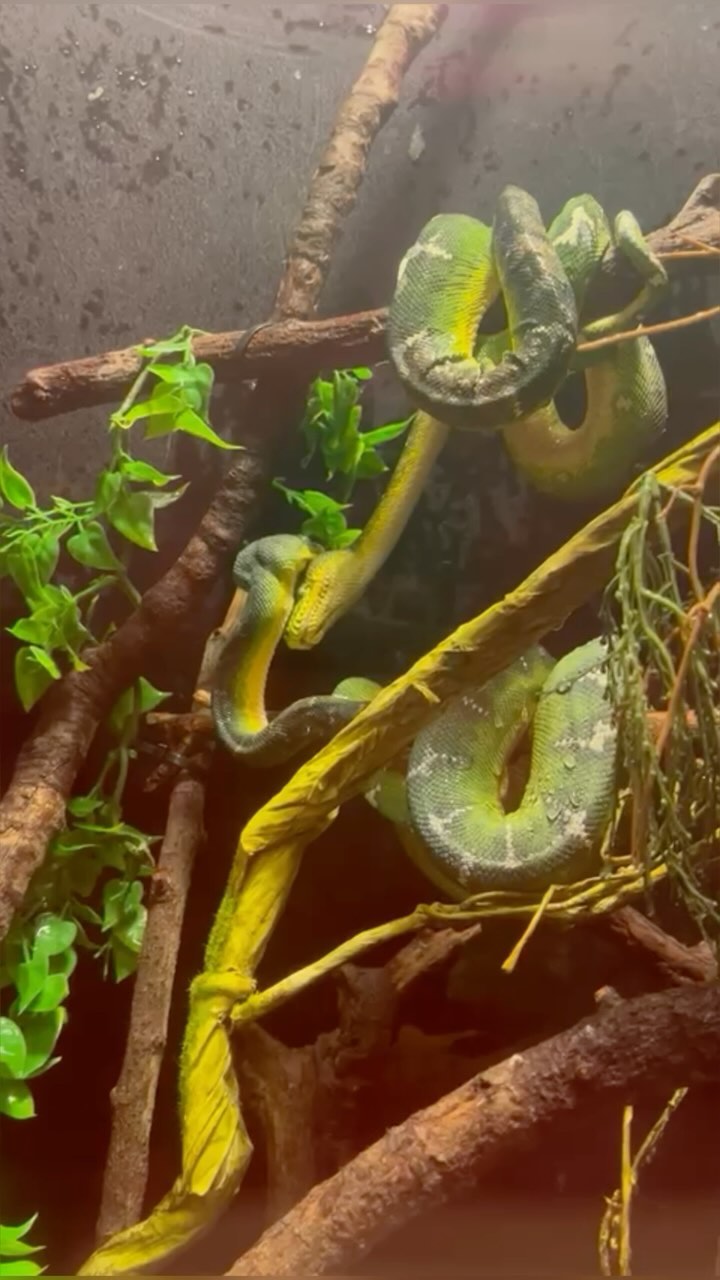– The mesmerizing beauty of Emerald Tree Boas in their natural environment.
– Unique behavioral patterns of Emerald Tree Boas and their interactions when in pairs.
– The significance of maintaining an eco-friendly habitat for these remarkable serpents.
– Insights into the reproduction and offspring care of Emerald Tree Boas.
– Conservation efforts and ethical considerations of exhibiting Emerald Tree Boas professionally.
Within the lush canopies of the Amazon rainforest, adorned with a palette of greens that seem to outshine even the most vibrant gemstones, lies a creature whose very presence encapsulates the splendor of Mother Nature – the Emerald Tree Boa. These serpents, with their glorious emerald hues and coiled poise, are not just solitary marvels; having two in proximity often reveals fascinating dynamics that capture the imaginations of enthusiasts and casual observers alike.
The Emerald Tree Boa, or Corallus caninus, has long been the subject of intrigue and marvel due to its stunning appearance and arboreal lifestyle. This non-venomous snake species is known for its striking green color punctuated by white markings that seem to dance along their scales. They have a robust, rigid body and a prehensile tail, allowing them to maneuver through the dense foliage easily. But there is something truly unique about witnessing a pair of these majestic creatures together.
Regarding their social interaction, Emerald Tree Boas might not be considered the most social creatures, but interesting behaviors emerge when the two are close. They are primarily solitary, with their well-known arboreal habitats allowing them minimal interaction. However, when they cross paths, the exchange is intriguing. During mating season, males actively seek out females, using scent trails to guide them. Once they find a suitable partner, an elaborate dance that could last weeks begins; it’s a meticulous process with mutual consent, a spectacle of nature that underlines the careful selection and propagation of the species.
The importance of an eco-friendly habitat cannot be overstressed for these arboreal marvels. They rely on the delicate balance of their rainforest ecosystem for survival. Emerald Tree Boas have adapted to live in their home environment with minimal ground interaction. They find solace and hunting grounds in the trees, where they blend seamlessly thanks to their coloration. Any disturbance to this habitat can have detrimental consequences for the boas and the intricately linked network of life within the canopy.
Reproduction among Emerald Tree Boas is another fascinating subject. They give birth to live young, a rarity among snakes. The gestation period can last up to seven months, culminating in the birth of 5-15 miniature boas, each already exhibiting an adult’s captivating green pigmentation and instinctual behaviors. The care of the mother in the initial stages following birth is critical. These neonates are independent from birth, but the mother remains protective, ensuring they have the best start in their arboreal world.
For those in professional settings, such as zoos and conservation centers, exhibiting Emerald Tree Boas can be a significant draw and an educational tool. Still, it comes with ethical responsibilities. Providing an environment that mimics their natural habitat is imperative for the health and well-being of these snakes. This includes vertical space for climbing, appropriate foliage for concealment, and a temperature-controlled environment that allows them to thermoregulate as they would in the Amazon. Above all, respecting the animals by giving them space and life as close to nature as possible is paramount.
Emerald Tree Boas are captivating not only because of their lush, vibrant color and remarkable adaptive evolution but also because they serve as a living reminder of the importance of conservation and respect for the natural world. As a species, these snakes play an essential part in the ecological web of the Amazon. Since collectors often target their beauty, they remind us of the delicate line between admiration and exploitation.
The verdant forests where Emerald Tree Boas thrive are intricate tapestries of life, and the snakes themselves are vital threads within. These forests provide the environmental conditions necessary for the boas to flourish and a multitude of potential prey, such as small mammals, birds, and occasionally reptiles, allowing them to play an integral role in controlling populations and maintaining balance.
As you traverse the idea of these remarkable creatures and immerse yourself in the verdant splendor of their world, it’s essential to reflect on the broader picture. Every species has its poetry, a unique verse in the epic of biodiversity. For the Emerald Tree Boas, it’s one of quiet majesty and solitude, interspersed with moments of profound connection when two of their kind come together.
In conclusion, whether alone or in pairs, the Emerald Tree Boa’s existence begs reflection on our part in preserving and celebrating nature’s treasures. As we learn more about these snakes and their complex world, we are reminded of the interconnectedness of all living things and our responsibility to protect the fragile ecosystems they call home. The story of the Emerald Tree Boas, entwined and solitary, is a testament to the wonder of the natural world, invoking a call to action for us to become passive spectators and active guardians of the planet’s myriad of life.
*****
Source Description
Two Emerald Tree Boas are better than one. 🐍

